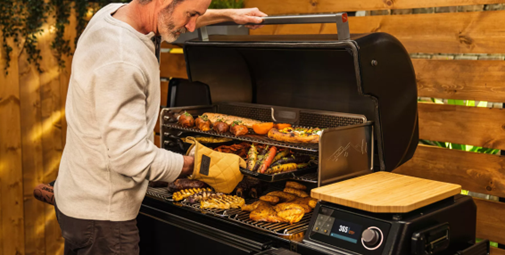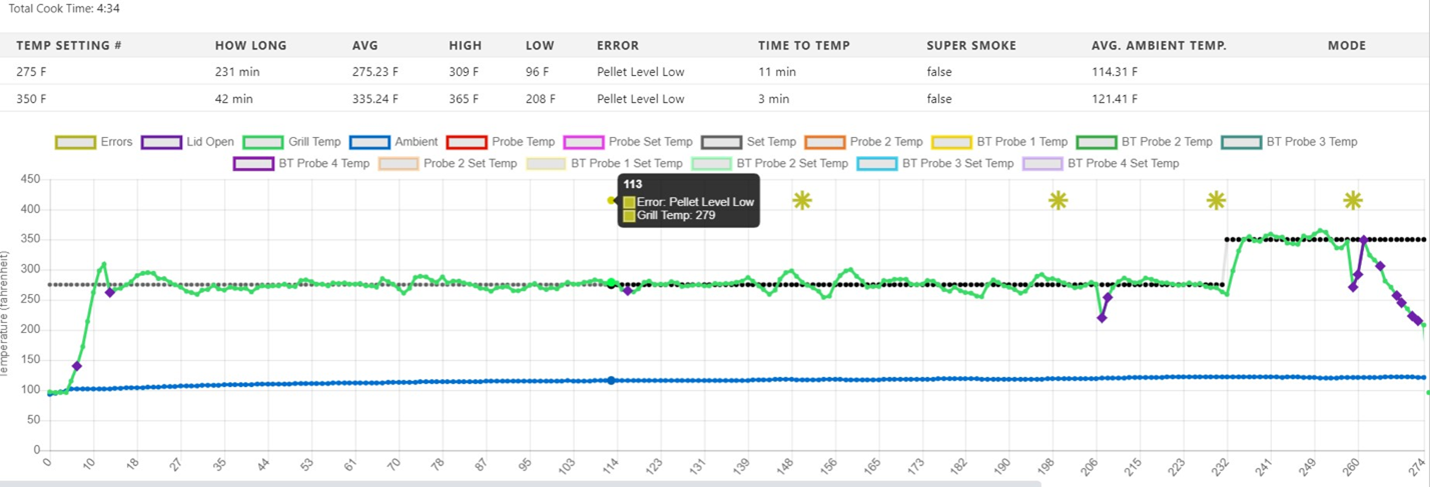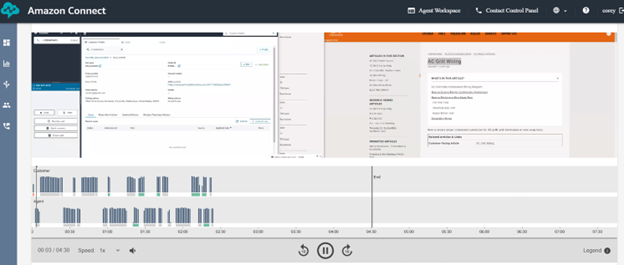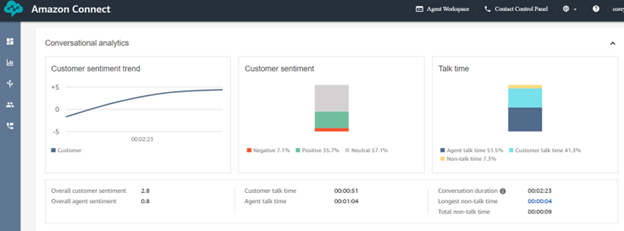No Jitter spoke with Corey L Savory, VP Global Customer Experience & Service with Traeger Grills about the customer experience she’s helped build over the last several years. Corey spent the first 13 years of her customer service career at DIRECTV where she served in multiple roles across the service organization, moved through TE Connectivity and iRobot, then went to Traeger in 2019. While at Traeger, Savory has driven a 32% improvement in CSAT and 50% improvement in FCR in under a year, and reduced warranty spend by more that 50% (as described later in this article). In this video, Savory and others at Traeger Grills provide a brief overview of how they implemented Amazon Connect to help drive those improvements.
WiFIRE, Traeger Grills’ clever turn of phrase, describes an equally clever implementation of Internet of Things (IoT) and smartphone app connectivity built into many of its wood pellet grills.
When a Traeger Grills customer first connects their new grill to their home Wi-Fi network and freshly installed app, the grill’s unique identifier (UID) is linked to the customer during their account creation process (which includes, email, phone number, etc.). Because of that Internet connectivity, customers don’t have to be at home to operate or monitor their grill. “You can be at the supermarket picking up ingredients and checking on how your cook is going – if you're making a brisket, [you’re] checking in on the internal temperature of the meat and understanding how your cook is progressing,” said Savory.
When the grill is started, the IoT sensors begin providing various types of information: the ambient temperature, the grill’s set temperature, how long it takes the grill to get to set temperature, how frequently the temperature on the grill is changed, temperature fluctuations, when the lid is opened, pellet level in the hopper, how the pellets are being fed, etc. Traeger can also push firmware updates to the grills to fine tune the way they function.
Suppose a customer’s smoked wings turn out horribly and they call Traeger’s support line. First, Traeger does the basics and matches the Caller ID to the account and the specific grill (via the UID). “Our agents will then look at the customer’s specific data – not at an aggregate level where we're using it for machine learning, but the most recent cook, the set temperature, how long they cooked and any error messages that might have appeared,” Savory said. “We won't know they were cooking chicken per se but if their wings didn't turn out well and we saw they were smoked at 200 degrees for 14 hours, that would be a pretty strong indicator as to why.”
That IoT data is delayed by a few minutes as it traverses the Internet, enters Traeger’s AWS cloud instance, and then gets processed by their systems. “If you were troubleshooting your grill because you feel it's not functioning properly and you call in, our agents will have you do a test cook and, in near real time, be able to see what's actually happening on your grill,” Savory said. “If the customer opts in, the other technology we use is Loupe. The agent sends a text message and, once the customer accepts, they can access the cell phone camera [via Loupe] to see in real time how clean the grill is, how it's functioning, etc.” (Note: Loupe is a video streaming technology that was built by Consilium on AWS. Consilium is a boutique software/consulting firm and AWS partner.)
Traeger is currently working on machine learning (ML) models that leverage the IoT data coming from the grills to “more accurately diagnose and understand how the grills are functioning as well as derive insights that power cross-functional decisions.”
That attention to data manifests in couple of areas, one being a current ML sprint that is taking Traeger’s knowledge of how the grills function best and comparing it against user behaviors, based on the IoT data, that lead to excellent cooks. (Note: “cooks” refers to the cooking process rather than those who collaborated to smoke wings for 14 hours.)
“We're training the AI to look for those [behaviors] and comparing [them] against customers with very high net promoter scores and customers with very low net promoter scores [to determine] the user behaviors tied to those segments, so that we can understand what the behaviors are of people with high NPS [net promoter score] with their grill versus customers who have low NPS,” Savory said. The company is exploring whether there might be a correlation between good cooking behaviors and good outcomes as well sub-optimal behaviors correlating to poor outcomes. “But we’ll wait for the data to come back in and let us know that for sure.”
Beyond this ML use case, Savory said that Traeger is exploring the use of generative AI to help the agents when interpreting the cook data. The following graphic shows what the agent would see when accessing a customer’s grill. Savory said that Traeger is busy ingesting the IoT data both at a high level to understand how customers are using the grills, and also at the individual level.
As in the smoked wings example, that single bad cook could be an outlier or part of a trend. Either way, when that customer calls in the agent must spend time interpreting that individual cook to figure out what happened. This diagnostic process might include examining previous cooks, as well. This is part of agents’ training, Savory, said, but “it takes time to really get proficient. Maybe one cook was a little wonky, but maybe there's absolutely nothing wrong and all the cooks around it are perfectly fine.”
So instead of the agent drilling down on each of a customer’s cooks and diagnosing multiple cooks while also interacting with the customer Traeger is “looking to train a generative AI model that can [analyze] a customer’s cooks over a period of time and [generate] a score – maybe a green check mark – [to indicate that] the grill seems to be operating just fine. Or maybe [the opposite], that the customer has been frequently opening the lid,” Savory said. Each behavior would generate a different score with its own unique icon that are then presented to the agent during the interaction. The idea is to more quickly “surface those insights to agents in a more consistent way [that also] takes some of that human interpretation out of it.”
This type of approach to customer support is a far cry from how Traeger operated prior to when Savory started with the company in September of 2019. “When I came to Traeger we were fully dependent on our third-party call center partner,” Savory said. “We would wait for spreadsheets [to be] sent through email – and it was self-reported performance.”
Since Savory began with Traeger, she’s helped drive a renewal in Traeger’s customer experience. The company Traeger selected Amazon Connect as their contact center platform (and AWS is their cloud platform which is where the IoT data is hosted). The first step in that process was getting the phone number ported over from traditional telephony. That took a couple days, but once they had that it was just redirected to Amazon Connect.
After the number was ported, it took three days for Traeger to get Amazon Connect turned up. They started on a Friday afternoon, Savory recalled. “My technology partner Bryan got it running over the weekend and we were fully operational for Monday morning. We were then able to leverage QuickSight in real time to access to all our contacts and data for the first time ourselves.”
With AWS, Traeger has since built a knowledge base of articles (one of which is shown below) which it now leverages, via Amazon Connect’s Wisdom, to surface suggested articles based on that conversation. (Wisdom “listens” to the interaction between customer and agent). This functionality saves the agent from having to search the knowledge base during the interaction. Savory said these interactions are used to continually “train the model to better surface more accurate content” during customer interactions.
Savory said this is part of their overall efforts to reduce the “cognitive load on our agents through everything we're doing – Wisdom, Loupe, the way we aggregate the data and surface those insights to our agents rather than relying on agents to work through all of that information themselves.” Traeger’s agents also have access to their own data through Amazon QuickSight, so they know how they're performing against goals rather than conferencing with their team leader as shown in the following graphic. (Note: For all the screenshots included in this article, Traeger used Amazon Connect Contact Lens to uncover trends and summarize key parts of the conversations.)
Traeger’s customer interaction volume is highly seasonal – i.e., mostly the summer months. “The first summer I was with Traeger we had about 550 agents,” Savory said. “Since then, through our KPI performance improvements with diagnostic accuracy and first contact resolution we’ve been able to reduce that to 400 to 500. In fact, we have a smaller call center footprint now than we did when I came on board.”
Those agents are employed by a business process outsourcer (BPO) but are dedicated to Traeger and don’t take calls for other companies. The new hire training period is two weeks and is designed to take the agents from perhaps not knowing how to operate a grill to being able to take calls. From there, Savory said their agents spend a week coming up to speed on the floor. “In my experience, it's usually about a 90-day ramp for traditional call center agents to hit proficiency. We've been able to reduce that down to 45 days thanks to getting high quality agents, excellent KPIs and diagnostic accuracy through using the tools in Amazon Connect.”
Savory’s also led other substantial CX improvements. When she started, first contact resolution (FCR) was at 35% with long wait times and they were at 45% “Top Box” customer satisfaction (CSAT). (Top Box scoring is a way of analyzing CSAT data by adding the “top boxes” on the rating scale.)
FCR was low because Traeger’s contact center providers were paid by the phone call so “there wasn't a whole lot of incentive for them to get it right,” she said. Moreover, the agents did not diagnose issues with the grill very well. Rather than accurately identify and address the problem the first time, the agents offered possible solutions and told customers to call back if it didn’t work which obviously led to multiple callbacks and contributed to the poor CSAT rating. Agents would also send replacement parts or replace the entire grill which resulted in high warranty costs and spending.
Today, Traeger’s FCR is at 75% and today they are at 94% Top Box CSAT – “the highest we've gotten is 95%,” Savory said. “And I've reduced warranty spend by 50% over a three-year period just by improving our ability to diagnose in that first contact.” And, Traeger’s BPO is no longer compensated on a per-call basis.
Within minutes after a support/service interaction has ended, customers receive a survey asking about that experience. If Traeger sent a part to the customer to fix the grill, then Traeger sends a follow-up survey that arrives about 10 days after tracking indicates that the part arrived at the customer’s home. The sending of that survey is delayed because, as Savory said, it may take the customer a few days to have time to swap the part out on their grill – and that’s key, because the last survey asks if the part actually fixed the issue.
“We have a team of agents I call CSAT masters whose job all day every day is to read the surveys as they come back. They’re not just boiling that information down to insights into where we need to improve,” Savory said. “If a customer indicates on the survey that they're not satisfied or their issue was unresolved, then these agents reach out and continue the conversation to make sure they’re on a path to resolution.”
Savory continued, saying that if the customer takes time to fill out a survey and share their experience and if they say that they're not satisfied then “it's on us then to do something about that and be proactive in ensuring that our customers are receiving resolution versus having to on call us back over and over again to tell us something didn't work.”
Currently, Traeger receives about 3,000 surveys per week and these agents are continually following up on the roughly 5% of customers who say they aren't satisfied. “Even if a customer says they're satisfied and they had a great experience, if there's something in the verbatim comment from the customer that leads us to wonder if they're really going to get the right resolution then we also follow up on those.”
Savory said they have two to three team members working that channel all day, every day whenever they’re open. “If you wait to follow up on feedback, the customer is less likely to answer their phone when you call. The faster we get to those surveys as they come in, the more likely the customer is to pick up and continue working with us.”
Generative AI-powered solutions would, of course, aid in this process with the models’ capabilities around summarization. And while Savory said they are looking at options there, they are already using ML to provide sentiment analysis and categorization of the themes and tone of the survey results.
Moving forward, Savory said that she has implemented a new metric this year which involves an understanding of the repurchase cycle and repurchase rate. Like many companies, Traeger measures their NPS to understand customer sentiment and word of mouth. “CSAT is still the customer saying how they feel and net promoter is still taking a survey. Surveys are good, but I would rather look at the actual data of what people are doing,” Savory said. “In our systems, I can see what percentage of our customers are adding a second grill or upgrading to a new product. I can then watch that over time.”
She continued, saying that over the next two years she believes the repurchase metric will become the true leading indicator on Traeger’s customer health “because we know how many new customers we attract and therefore our penetration in market and what percentage of households have our products. But keeping customers happy and seeing that they’re brand loyal and staying with Traeger for the long run, I think is the really important thing. We'll see how that shapes up over the next couple years.”















